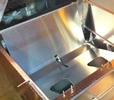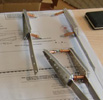


random user submitted photo
stall speed at gross
6 posts
• Page 1 of 1
stall speed at gross
Have any builders established using GPS the clean stall speed at gross of their Sonex/Waiex?
The nominal wing loading of the Sonex is higher than average among the LSA, so the fuselage must be providing some of the lift.
The nominal wing loading of the Sonex is higher than average among the LSA, so the fuselage must be providing some of the lift.
- KWK
- Posts: 3
- Joined: Tue Jul 26, 2016 11:24 pm
- Location: Illinois
Re: stall speed at gross
I never set out to measure this number to the precision you want, but I did find a gross-weight flight where I performed two stalls and I flew in enough directions that I believe I can estimate the wind speed.
Aircraft weight: 1125lbs (took off at 1150lbs and burned ~25lbs of fuel; this flight was performed at greater than Sonex's recommanded gross weight for the Aerovee engine.)
Density altitude: 4000ft
Tailwind during the stall: 7mph (my greatest uncertainty, but I did record GS and TAS while flying around in several circles, so feel like this is a reasonable estimate)
Minimum GPS ground speed during the stalls: 43mph (35mph IAS)
Estimated clean stall TAS: 50mph (43mph+7mph)
Stall speed corrected to sea level density altitude: 50mph * sqrt(1.088/1.225) = 47mph
Sonex lists the clean stall speed as 46mph. I feel like my estimate of 47mph agrees remarkably well with theirs. Both are comfortably within the LSA rule of 51mph.
Here's a recent quote from John Monnett about the fuselage lift:
I'd be interested in seeing a comparison against other more rounded fuselage designs.
Aircraft weight: 1125lbs (took off at 1150lbs and burned ~25lbs of fuel; this flight was performed at greater than Sonex's recommanded gross weight for the Aerovee engine.)
Density altitude: 4000ft
Tailwind during the stall: 7mph (my greatest uncertainty, but I did record GS and TAS while flying around in several circles, so feel like this is a reasonable estimate)
Minimum GPS ground speed during the stalls: 43mph (35mph IAS)
Estimated clean stall TAS: 50mph (43mph+7mph)
Stall speed corrected to sea level density altitude: 50mph * sqrt(1.088/1.225) = 47mph
Sonex lists the clean stall speed as 46mph. I feel like my estimate of 47mph agrees remarkably well with theirs. Both are comfortably within the LSA rule of 51mph.
Here's a recent quote from John Monnett about the fuselage lift:
“They’re basically a box with a lifting body that’s created by a smooth canopy and cowling transition. That contributes tremendously to its performance at both low-speed and high-speed operations.”
I'd be interested in seeing a comparison against other more rounded fuselage designs.
- gammaxy
- Posts: 600
- Joined: Wed Sep 04, 2013 9:31 am
Re: stall speed at gross
47? I'd have bet it was closer to 51. Impressive performance. Thanks for the info.
- KWK
- Posts: 3
- Joined: Tue Jul 26, 2016 11:24 pm
- Location: Illinois
Re: stall speed at gross
At 950 lbs (aerobatic weight) my stall speed is 26 kts indicated. There is probably some pitot error due to a high angle of attack, but I can keep flying straight ahead with rudder, and it won't start nosing down until 26 kts. At that weight I break ground on take off at 36 kts indicated.
Mike Smith
Sonex N439M
Scratch built, AeroVee, Dual stick, Tail dragger
http://www.mykitlog.com/mikesmith
Sonex N439M
Scratch built, AeroVee, Dual stick, Tail dragger
http://www.mykitlog.com/mikesmith
- mike.smith
- Posts: 1430
- Joined: Tue Jan 29, 2013 8:45 pm
Re: stall speed at gross
Is that with any flaps down?
Darick Gundy
Sonex #1646
N417DG
Taildragger, Aerovee, center stick, Prince P-Tip Prop
MGL E1, F2, V6 radio, Sandia Xponder, Reserve lift indicator (AOA), iFly 520
First flight! 10/21/2017
Sonex #1646
N417DG
Taildragger, Aerovee, center stick, Prince P-Tip Prop
MGL E1, F2, V6 radio, Sandia Xponder, Reserve lift indicator (AOA), iFly 520
First flight! 10/21/2017
-

Darick - Posts: 496
- Joined: Mon Aug 05, 2013 9:39 pm
- Location: PA
Re: stall speed at gross
No flaps.
Mike Smith
Sonex N439M
Scratch built, AeroVee, Dual stick, Tail dragger
http://www.mykitlog.com/mikesmith
Sonex N439M
Scratch built, AeroVee, Dual stick, Tail dragger
http://www.mykitlog.com/mikesmith
- mike.smith
- Posts: 1430
- Joined: Tue Jan 29, 2013 8:45 pm
6 posts
• Page 1 of 1
Who is online
Users browsing this forum: No registered users and 55 guests







